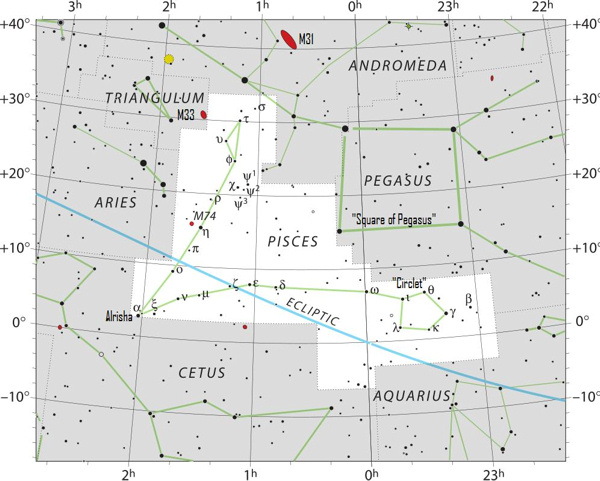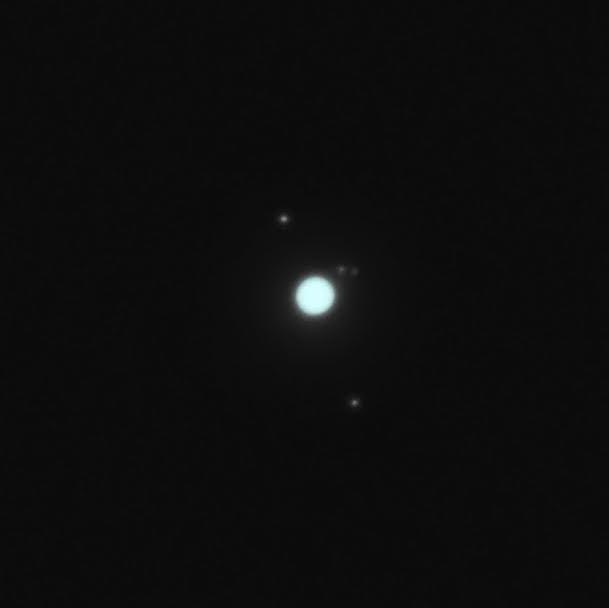
Tonight – January 14, 2019 – the waxing gibbous moon is roughly one day past first quarter phase and shines rather close to the 7th planet, Uranus, on the sky’s dome. Uranus is located in front of the constellation Pisces the Fishes, though very close to the border of the constellation Aries the Ram. This faint planet – barely bright enough to be glimpsed with the eye alone on a moonless night – will cross over into the constellation Aries in February 2019.
Meanwhile, the moon will leave this section of the starry sky after a day or two. That means you can use tonight’s moon location – and links to detailed charts and other info, found in this post – to try to find faint Uranus.
Now notice Mars! It’s pretty bright easily the brightest starlike object in front of the faint constellation Pisces. About a month from now – on February 13, 2019 – Mars will pass one degree north of Uranus. For a week or so centered on that date, Uranus and Mars will be in the same binocular field.
The night of January 14 is not the best night to look for Uranus. You’ll have a tough time glimpsing it in the moon’s glare. But read on, maybe bookmark some links, and then, when the moon leaves the evening sky, you’ll know where to look before Mars meets up with Uranus near mid-February 2019.

View larger. | If you’re not sure how to find Pisces, maybe you can find the Great Square of Pegasus. It’s your jumping off point for finding Pisces’ place in the great celestial sea. Also, notice the Circlet in Pisces. It’s very noticeable in a dark sky. Notice that the star Omicron is located near the ecliptic and close to the border of Aries.
Notice the graceful V shape of the constellation Pisces. If you have a dark sky, which you’ll need anyway in order to see Uranus, you’ll easily make out the V of Pisces on the sky’s dome. You can star-hop to Uranus via the 4th-magnitude star Omicron Piscium. See this star on the sky chart above marked as “o”?
Click here if you’re not familiar with Greek letter symbols
Okay … got Omicron?
Now you just need to know Uranus’ location with respect to this star for the current observing season (May 2018 – March 2019). Best place to find that is nearly always skyandtelescope.com. People with good vision – and a good chart, like this one – can see Uranus with the unaided eye on dark, moonless nights. Of course, binoculars make the search for Uranus all the easier!
Be sure to click into the full chart, but here’s the relevant piece of it – for finding Uranus – below.
Ice giants Uranus and Neptune from skyandtelescope.com
By the way, Uranus was the first planet to be discovered via telescope, by William Herschel on March 13, 1781. At a distance of 20 astronomical units from Earth at present, this world is pretty easy to see through binoculars – that is, if you know right where to look.
Just remember, with the moon waxing to full now, unaided eye glimpses of Uranus won’t be likely in the coming nights. We hope the charts on this page will help you find Uranus later!

Steven Bellavia sent in this image of Uranus and 4 of its moons in December, 2018. From upper left to lower right: Titania, Ariel, Umbriel, Oberon. Steve wrote: “Uranus has 27 moons, all of which are named after characters from the works of William Shakespeare and Alexander Pope … I find it amazing that William Herschel was able to see (and discover) Titania and Oberon, in 1787, only 6 years after he discovered the planet itself, using his home-built 18.8-inch telescope. Umbriel and Ariel were not discovered for another 64 years by William Lassell in 1851.”
Voyager 2 is still the only spacecraft to have visited the outer planets Uranus and Neptune. Here is Uranus as seen by Voyager 2 in 1986. To the spacecraft, the planet appeared as a featureless blue ball. Image via NASA.
Bottom line: As darkness falls on January 14, 2019, the moon and planet Uranus both reside near the bottom of the “V” in the constellation Pisces the Fishes.
EarthSky astronomy kits are perfect for beginners. Order today from the EarthSky store
.
from EarthSky http://bit.ly/2QMEnl5

Tonight – January 14, 2019 – the waxing gibbous moon is roughly one day past first quarter phase and shines rather close to the 7th planet, Uranus, on the sky’s dome. Uranus is located in front of the constellation Pisces the Fishes, though very close to the border of the constellation Aries the Ram. This faint planet – barely bright enough to be glimpsed with the eye alone on a moonless night – will cross over into the constellation Aries in February 2019.
Meanwhile, the moon will leave this section of the starry sky after a day or two. That means you can use tonight’s moon location – and links to detailed charts and other info, found in this post – to try to find faint Uranus.
Now notice Mars! It’s pretty bright easily the brightest starlike object in front of the faint constellation Pisces. About a month from now – on February 13, 2019 – Mars will pass one degree north of Uranus. For a week or so centered on that date, Uranus and Mars will be in the same binocular field.
The night of January 14 is not the best night to look for Uranus. You’ll have a tough time glimpsing it in the moon’s glare. But read on, maybe bookmark some links, and then, when the moon leaves the evening sky, you’ll know where to look before Mars meets up with Uranus near mid-February 2019.

View larger. | If you’re not sure how to find Pisces, maybe you can find the Great Square of Pegasus. It’s your jumping off point for finding Pisces’ place in the great celestial sea. Also, notice the Circlet in Pisces. It’s very noticeable in a dark sky. Notice that the star Omicron is located near the ecliptic and close to the border of Aries.
Notice the graceful V shape of the constellation Pisces. If you have a dark sky, which you’ll need anyway in order to see Uranus, you’ll easily make out the V of Pisces on the sky’s dome. You can star-hop to Uranus via the 4th-magnitude star Omicron Piscium. See this star on the sky chart above marked as “o”?
Click here if you’re not familiar with Greek letter symbols
Okay … got Omicron?
Now you just need to know Uranus’ location with respect to this star for the current observing season (May 2018 – March 2019). Best place to find that is nearly always skyandtelescope.com. People with good vision – and a good chart, like this one – can see Uranus with the unaided eye on dark, moonless nights. Of course, binoculars make the search for Uranus all the easier!
Be sure to click into the full chart, but here’s the relevant piece of it – for finding Uranus – below.
Ice giants Uranus and Neptune from skyandtelescope.com
By the way, Uranus was the first planet to be discovered via telescope, by William Herschel on March 13, 1781. At a distance of 20 astronomical units from Earth at present, this world is pretty easy to see through binoculars – that is, if you know right where to look.
Just remember, with the moon waxing to full now, unaided eye glimpses of Uranus won’t be likely in the coming nights. We hope the charts on this page will help you find Uranus later!

Steven Bellavia sent in this image of Uranus and 4 of its moons in December, 2018. From upper left to lower right: Titania, Ariel, Umbriel, Oberon. Steve wrote: “Uranus has 27 moons, all of which are named after characters from the works of William Shakespeare and Alexander Pope … I find it amazing that William Herschel was able to see (and discover) Titania and Oberon, in 1787, only 6 years after he discovered the planet itself, using his home-built 18.8-inch telescope. Umbriel and Ariel were not discovered for another 64 years by William Lassell in 1851.”
Voyager 2 is still the only spacecraft to have visited the outer planets Uranus and Neptune. Here is Uranus as seen by Voyager 2 in 1986. To the spacecraft, the planet appeared as a featureless blue ball. Image via NASA.
Bottom line: As darkness falls on January 14, 2019, the moon and planet Uranus both reside near the bottom of the “V” in the constellation Pisces the Fishes.
EarthSky astronomy kits are perfect for beginners. Order today from the EarthSky store
.
from EarthSky http://bit.ly/2QMEnl5

Aucun commentaire:
Enregistrer un commentaire